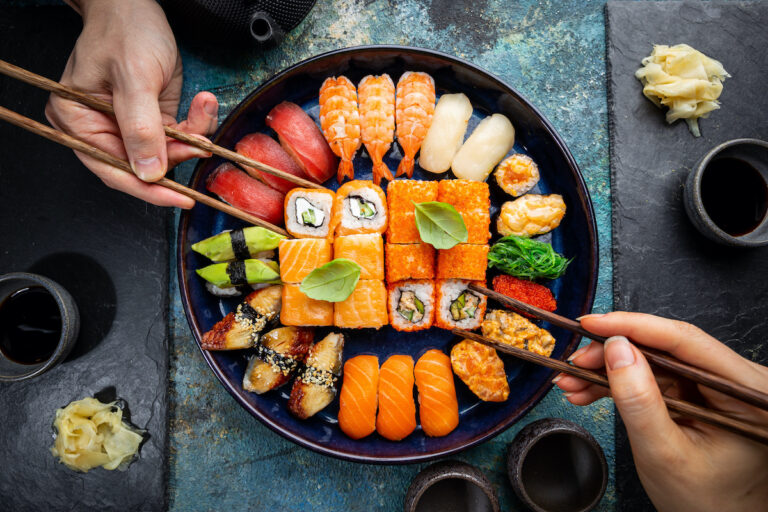Sushi is one of the most popular and beloved dishes in the world. Whether it’s sushi rolls, sashimi, or nigiri, Sushi downtown Phoenix has captured the hearts of millions across the globe.
But have you ever wondered how sushi became today’s global phenomenon? Its history is rich and fascinating, stretching back over a thousand years.
From its humble beginnings as a simple preservation method to its rise as a fashionable dish in the modern world, sushi has transformed in many ways. Let’s take a closer look at how sushi became today’s international sensation.
The Origins Of Sushi
Sushi’s origins can be traced back to ancient Southeast Asian times, long before it became the dish we know and love today.
The process involved wrapping fish in rice, which helped preserve it by allowing it to ferment. The fermented rice was thrown away, and only the fish was consumed.
This preservation technique evolved in Japan. By the 8th century, fermenting fish with rice spread across the country.
However, sushi did not begin to take on the form we recognize today until the Edo period (1603-1868).
The Birth Of Modern Sushi
The transformation of sushi began during the Edo period in Japan. The development of nigirizushi, the sushi most people are familiar with, took place in the early 19th century.
In the bustling city of Edo (now Tokyo), Hanaya Yohei is often credited with creating modern sushi.
Yohei’s innovation was to serve fresh fish on top of vinegared rice rather than fermenting it. He also introduced the idea of using raw fish, making the dish faster to prepare and easier to eat.
This sushi style, called nigiri-zushi (meaning “hand-pressed sushi”), became a hit with locals and quickly spread throughout the country.
Unlike earlier sushi, which required fermentation, nigiri-zushi was ready to eat immediately, making it a convenient street food for busy people in Edo.
Sushi Moves To The West
Sushi remained a Japanese specialty for many years, but by the mid-20th century, it started reaching the West.
The first significant step in sushi’s global journey occurred in the 1960s when sushi bars appeared in major cities like Los Angeles and New York.
Initially, sushi was a niche food enjoyed only by adventurous eaters and Japanese expatriates.
The real breakthrough came in the 1970s when Japanese immigrants and sushi chefs opened restaurants in the U.S., and sushi became more widely available.
Sushi’s International Popularity
In the 1980s and 1990s, sushi’s popularity exploded around the world. As the global food section became more diverse, sushi moved beyond its traditional Japanese roots and became fashionable in many countries.
In the U.S., sushi bars became trendy, especially in California, where chefs experimented with new rolls that combined traditional Japanese ingredients with Western flavors.
As sushi became more mainstream, it appeared in supermarkets, grocery stores, and fast food chains. Pre-packaged sushi became a convenient option for busy people, further spreading its appeal.
Sushi’s Continued Evolution
Today, sushi continues to evolve in response to changing tastes and trends. In Japan, new and inventive types of sushi, like temaki (hand rolls) and chirashi (sushi served in a bowl with rice and toppings), are becoming more popular.
At the same time, sushi in the West has grown to include creative twists, such as sushi burritos, sushi pizza, and even sushi made with non-traditional ingredients like smoked salmon or cooked shrimp.
While sushi’s basic elements—fish, rice, and seaweed—remain the same, chefs worldwide are experimenting with different flavors, textures, and presentation styles.
Sushi in Phoenix has become a canvas for culinary creativity, blending traditional techniques with new cultural ingredients and flavors.
The Global Phenomenon
Today, sushi is enjoyed by people of all cultures and backgrounds, and it has become a symbol of Japanese cuisine and culture worldwide.
Sushi’s success can be attributed to its versatility, emphasis on fresh ingredients, and ability to adapt to different tastes and preferences.
Whether you prefer traditional nigiri or modern fusion rolls, sushi offers something for everyone, making it a dish that transcends borders and brings people together.
Conclusion:
Sushi’s transformation from a simple preservation method to a worldwide culinary sensation is a testament to its timeless appeal.
It has adapted to changing times and tastes while still holding onto what makes it special: fresh, high-quality ingredients and a deep respect for the art of sushi-making.
Today, sushi is more than just a dish; it symbolizes Japan’s rich culinary tradition and a global culinary treasure millions worldwide enjoy.
If you want to experience authentic sushi with quality ingredients and expert craftsmanship, we invite you to visit Omoide Sushi & Noodle.
Our menu offers a variety of sushi options that stay true to tradition while embracing innovation. Whether you’re a sushi enthusiast or a first-timer, we’re here to share the joy of sushi with you in every bite.
